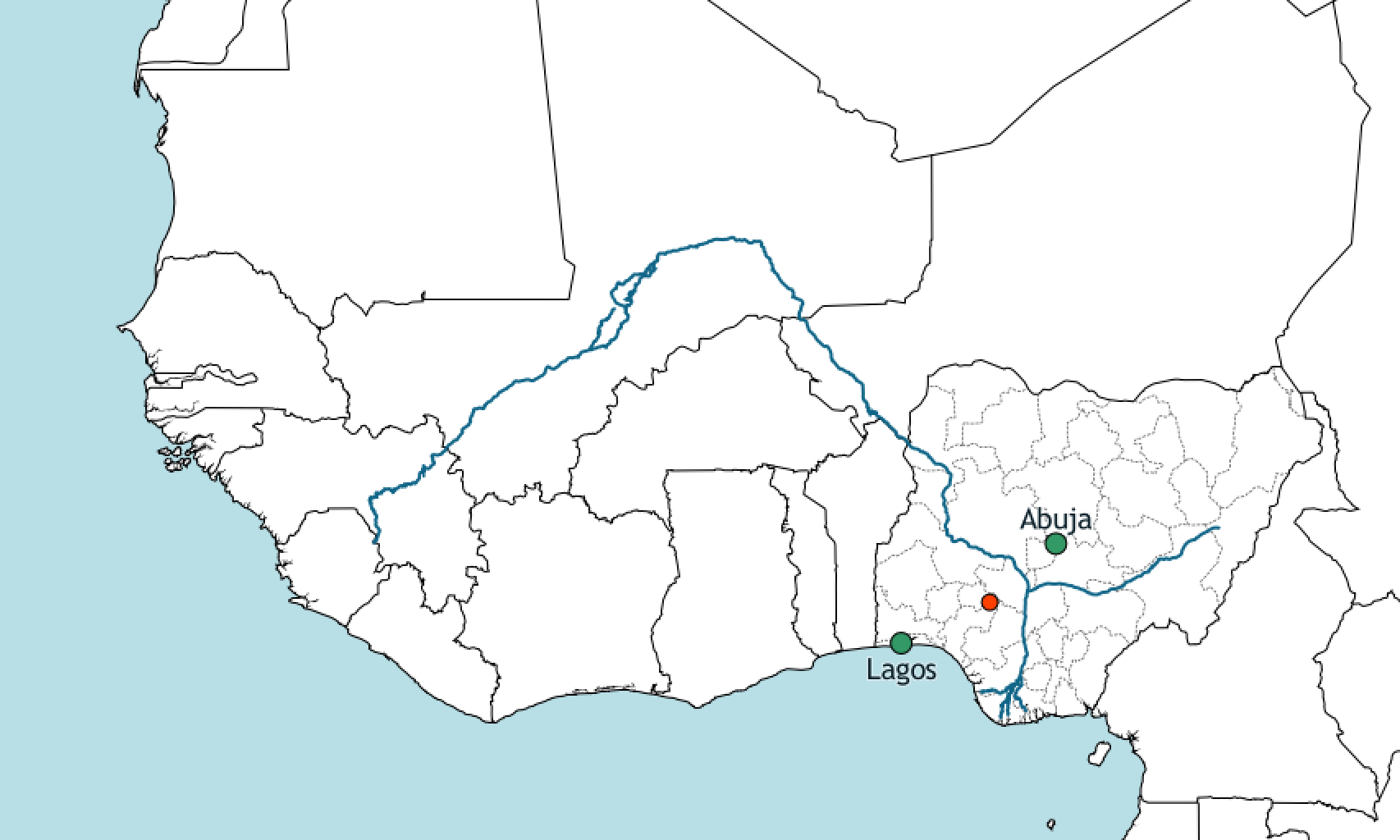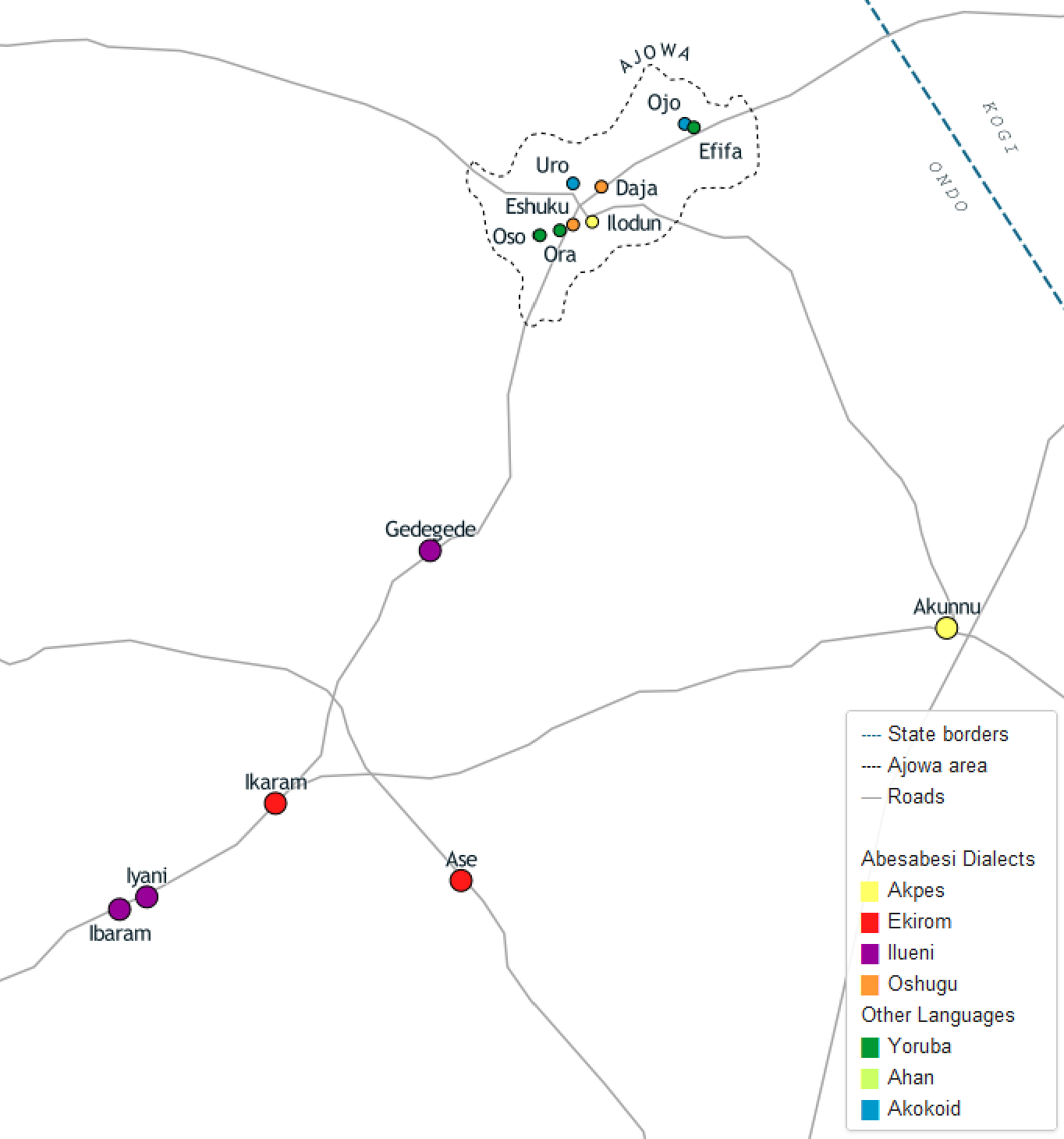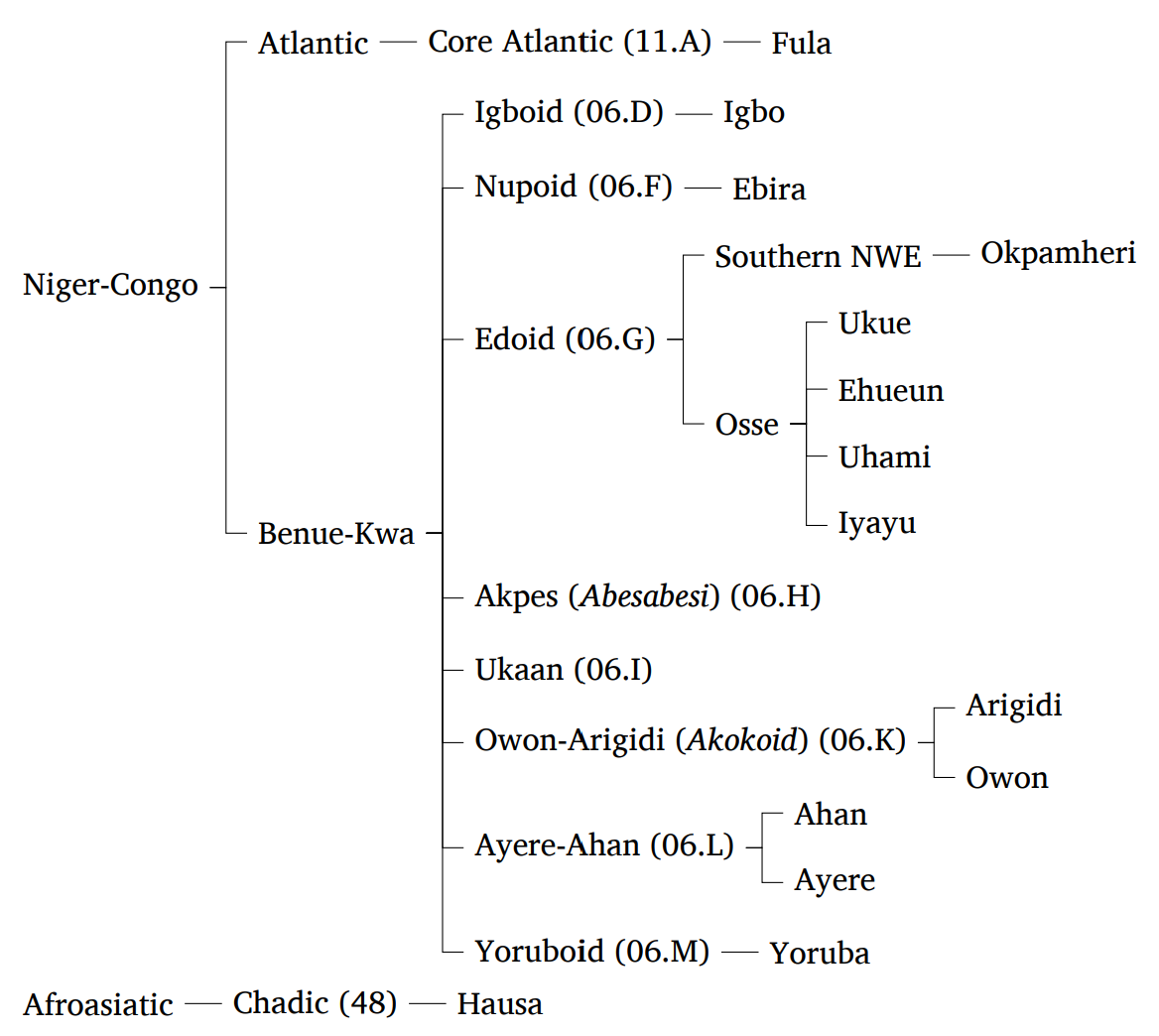Abesabesi is spoken in nine settlements in the north of Ondo
State, Nigeria. The red dot on Figure 1.1
indicates the location of these settlements within Nigeria and West
Africa.
Figure 1.1: Location of the Abesabesi speaking settlements (red dot) in Nigeria

They consist of six independent towns (Akunnu, Ase, Gedegede, Ibaram,
Ikaram, and Iyani) and three communities within the rather recently
founded town Ajowa. Disputes about land and sovereignty has led to a
relocation of seven different communities and resulted in the foundation
of Ajowa (Agoyi, 2014, p.
4). Of these seven communities, three are Abesabesi-speaking ones:
Daja, Eshuku, and Ilodun. Another community of Ajowa, the Efifa, are
known to have spoken a dialect of Abesabesi in the past but switched to
the local Yoruba variety Owe (Agoyi, 2013, p. 74). All of the Abesabesi-speaking towns and
the different quarters of Ajowa's communities can be seen in Figure 1.2.
Figure 1.2: The Abesabesi speaking communities

Figure 1.1, 1.2 and 1.3 are created by the author. Most of the GPS data
was provided by Sophie Salffner. Information about the town-language
relation has been taken from several sources - most notably Ohiri-Aniche (1999), Olumuyiwa and Oshodi (2012)
and Elugbe (1989). The maps
attribute one "native" language to each town. If not possible, towns are
marked with "multiple languages". Although the decision about which
language is "native" to a town is rather problematic, it is necessary to
such a cartographic approach. This means that the maps do not show the
lingua francas Standard Yoruba, English, or Nigerian Pidgin English; the
languages of various farm settlements and camps; nor the languages of
recent immigrants who settled down in the towns.
The Abesabesi-speaking area is located in the north of Ondo State in an
area referred to as "Akoko". This hilly region is composed of
four Local Government Areas (LGA). Except Akunnu, which is located in
the Akoko North East LGA, all other Abesabesi-speaking communities are
within the Akoko North West LGA.
The Akoko region is a highly multilingual area, where eight distinct
native languages are spoken next to the dominant lingua franca -
Standard Yoruba and its manifold local varieties of the region.
Moreover, the region is home to different immigrant communities such as
Ebiras, Fulanis, Hausas, and Igbos. Figure 1.3
displays all these languages in a tree structure that has been
simplified from Güldemann (2018,
pp. 353-356). Language names in italics are given if the name
used in this thesis deviates from the name used in Güldemann (2018). The
genetic affiliation of Abesabesi and alternative approaches to this tree
are discussed in Section 1.1.5.
Figure 1.3: Languages spoken in the Akoko region of Ondo State. Identifiers are taken from Güldemann (2018, pp. 353-356)

Figure 1.3 displays the different towns and villages
of the Akoko region with their respective native language. Yoruba is the
dominant language of the region. While Standard Yoruba is the lingua
franca of the region, different local varieties are native to most of
the Akoko towns, especially in the West and the South. The most notable
are Ikare, the largest local town, and Akungba, the home of the local
university.
Figure 1.3: Languages of the Akoko towns

The south of Akoko is home to a couple of Edoid languages of the Osse
branch (Elugbe 1989, p.
24). Ehueun spoken in Epinmi, Ukue spoken in Ipe and Igbede Ipe,
and Uhami spoken in Oyara Ishua, Ishua Oke, Ishua Ile, Shosan Oke and
Shosan Ile. The main area of Edoid languages extends further south and
east of the Akoko in Edo state.
In the east, the Ukaan language is spoken in Auga, Ishe, Ayanran and two
towns called Ikakumo. The language is sometimes also referred to as
"AIKA", an acronym for the five villages Auga, Ishe,
Kakumo, Kakumo and Ayanran. The genetic affiliation of Ukaan remains
controversial. It has been attributed to both West Benue-Congo and East
Benue Congo. Its closest relative based on the lexicon, however, seems
to be Abesabesi (Ohiri-Aniche
1999, p. 83).
In the north, seven towns and three communities within Ajọwa (Uro and
Ojo) speak Akokoid, a language cluster that is part of the Benue-Congo
branch. Fadoro (2013)
classifies Akokoid into two languages: Arigidi (spoken in Arigidi and
Erushu) and Owon (spoken in Eriti, Igashi, two quarters of Ajowa, Oyin,
Oke-Agbe and Iye). The whole cluster was originally grouped together
with Ayere and Ahan as the "Northern Akoko Cluster" by Hoffmann (1976).
Abesabesi is located in the north east of the Akoko region. It is
surrounded by Akokoid in the west, Yoruba in the south, Ukaan in the
east and Ayere in the north. Ikaram, where the data has been recorded,
is home to the native Abesabesi-speaking population, which is gradually
shifting to Yoruba.
In contrast to Abesabesi, which a lot of younger people and immigrants
do not speak, virtually everybody speaks Yoruba. Most people speak
Standard Yoruba as it is taught and spoken in schools, and some speak
local varieties. Apart from Yoruba, Nigerian English is spoken by people
with a higher education. Pidgin English is also common among less
educated people, especially in conversations with non-Yoruba speaking
people. Other peoples living in Ikaram include Yoruba, Ebira, and
Fulani. The Yoruba mainly came as spouses or in higher educated
positions such as priests, teachers, or medical personal. Only some of
them learned some Abesabesi. The Ebira have lived in Ikaram for a couple
of generations. Some Ebira (mainly older people) speak Abesabesi.
Nomadic Fulani are present in the whole Akoko region. Some of them have
been allowed to settle down in Ikaram in the past. Yoruba, Ebira, and
Fulani are generally seen as part of the community of Ikaram, recognize
the king (Akala) of Ikaram, and contribute to the town's festivals with
performances, masquerades, or speeches.